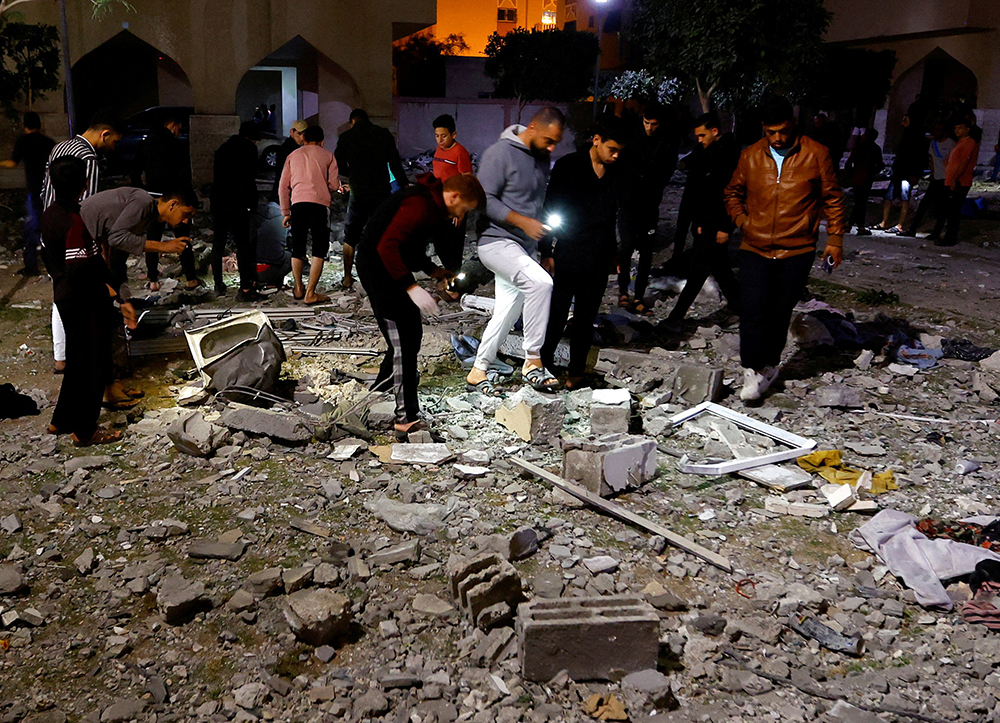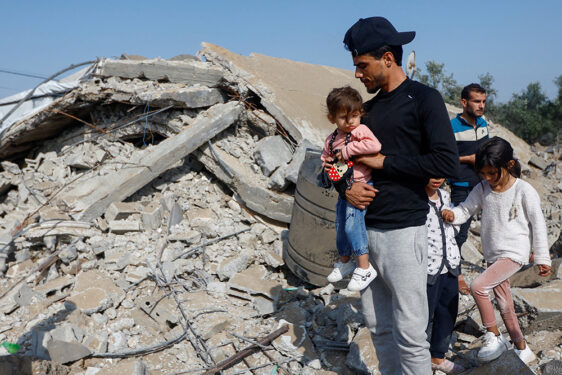
By Judith Sudilovsky
JERUSALEM (OSV News) — Faith leaders and activists for coexistence from across Israel gathered in prayer in front of the walls of the Old City of Jerusalem May 10, in a week that once again saw yet another increase in violence between Israel and the Palestinians.
The prayer march came after the May 2 death in prison of prominent hunger-striking Palestinian prisoner Khader Adnan, a leader and spokesman in the Islamic Jihad militant group. The announcement of his death was followed by a barrage of missile strikes into southern Israel by Islamic Jihad.
The prayer gathering took on more urgency following an early morning Israeli airstrike into Gaza May 9 that killed three senior Islamic Jihad militants and at least 10 civilians including the militants’ wives, several children and civilian neighbors in a residential building.
One of the Palestinian civilians killed in the early morning attack was Jamal Khaswan, a prominent dentist. His wife and son also were killed, according to the Palestinian Ministry of Health. Khaswan was known for offering free treatments to people who would not afford his medical services.
Israel said one of the militants killed had been responsible for the 2004 terrorist attack in which Tali Hatuel, who was pregnant, and her four children, ages 2 to 11, were killed.
In a first response to the Israeli attack, Islamic Jihad fired hundreds of missiles into Israel May 10, some reaching into the Tel Aviv area, and Israelis in the southern periphery were told to stay near their safe rooms. Israeli air defense systems intercepted the rockets, including some 44 miles from the Gaza Strip, above the skies of Tel Aviv. Israel said some 500 missiles have been fired at Israel since May 10.
Gaza Strip is densely populated with 2.3 million people living in an area of 140 square miles and has been under an Israeli and Egyptian blockade since 2007, when the militant Islamist group Hamas took over the area following elections and a bloody battle with the Fatah faction of Palestinian President Mahmoud Abbas.
As dusk fell over the skies in Jerusalem’s Old City, Sheik Ameed Adin chanted the prayer for peace of Abraham, the common patriarch of Judaism, Christianity and Islam, from the Ahmadiyya Islamic tradition.
“Our message is love for everyone, not hate,” he told the group of some 100 people who had taken part in the march from the center of Jerusalem to the Old City. They said it was to show their leadership in a time of strife, in the footsteps of the interfaith civil rights march of the Rev. Dr. Martin Luther King Jr. “We believe in this with all our heart and we have to sacrifice for this motto. It is not just an Ahmadiyya belief, it is in the Koran, in Islam, in the Bible, in all religions. We have to work for this together.”

Muslim peace activist Ghadir Hani, from the northern Israeli city of Acco, and Rabbi Lana Zilberman Soloway from the Jerusalem area said their prayers — recited in both Hebrew and Arabic — took on a special urgency now, and that it was important to see Arabs and Jews marching together at these very tense times, with the missile attacks continuing even as they prayed.
“Today we are praying for all the children in Gaza and for all the children living along the Gaza border in Israel. We are one, and we are the ones bringing light to all the people of this land,” Hani said. “This march is a very important statement.”
Father Piotr Zelazko, who is patriarchal vicar for the Hebrew-speaking Catholics in Israel, and who participated in the prayer march, said his own community views their numerous interfaith activities with Muslims and Jews as an important undertaking.
“This makes us experience that we, human beings, can live together in peace and understanding despite the painful and unresolved political problems,” he said. “The meeting in Jerusalem was addressed to the local community of Jerusalem as a message of hope that common life despite the differences is possible. There are many people who want peace, among them the religious leaders — Jews, Christians and Muslims.”
Over 30 organizations took part in the march, noted Rabbi Zilberman Soloway, and they will not give up their struggle for peace.
“We came, and we pray with our feet,” she said.
“We are coming together not to erase our differences but to celebrate our differences and recognize our deep human connection to one another,” noted the Rev. Muriel Pearson of the St. Andrew’s Church in Jerusalem.
News reports quoted the Palestinian Health Ministry as saying 25 Palestinians have been killed in the current round of attacks, including militants, and 76 injured, since the beginning of Israel’s operation. Reports say 10 civilians have been killed. Israel reported it had killed the fourth Islamic Jihad leader on the morning of May 11 in a targeted airstrike, along with two other members of the group.
By midday May 11, news reports said one Israeli had been killed and 14 were injured in different cities of Israel; some homes also have been damaged. As Israel continued with airstrikes, Hamas was still staying out of the fighting.
Israel uses a sophisticated air defense system called Iron Dome to intercept rockets, and all newer Israeli homes and buildings are required to have safe rooms, or similar safe areas, in case of missile attacks.
Islamic Jihad launched 10 more mortars into Israel May 11 morning according to news reports, and Israel said it had hit more than 130 targets including rocket-launching sites, military compounds, weapon manufacturing sites and a military post as it continued to strike targets May 10 in Gaza while Egypt began efforts to mediate a ceasefire.
